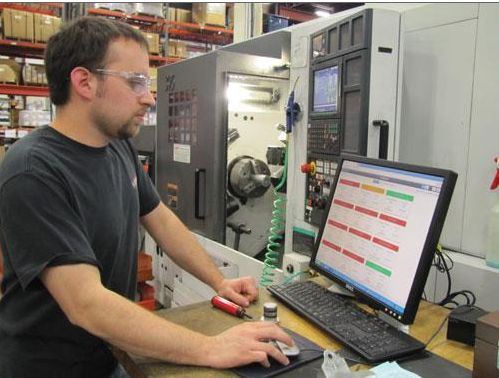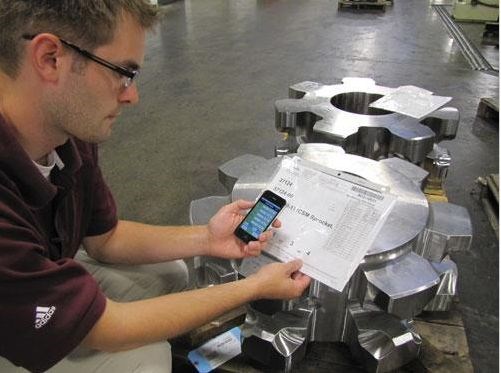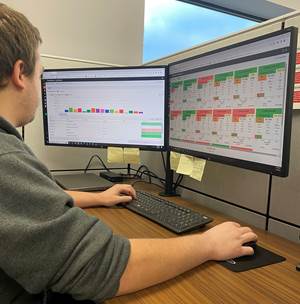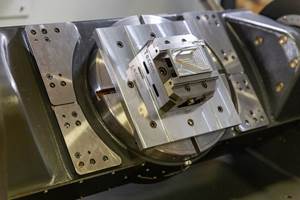These U.S. Shops Are Ready For the “Internet of Things”
For two manufacturing companies in northern Indiana, using MTConnect for machine monitoring was the start. This step forward is possible because this open and royalty-free standard for manufacturing uses proven Internet protocols.
Share





Industry 4.0 is more than a theoretical possibility for U.S. manufacturing companies that have adopted MTConnect. ITAMCO and Task Force Tips, both in the middle of America, show how they have a head start in realizing this concept by using XML and Internet Protocol technology as a common communication link to publish machine data over networks. By implementing MTConnect-enabled devices and linkages, they are well on their way to creating Cyber Physical Systems that are practical, affordable and effective.
That’s because MTConnect enables them to unlock data from machine tools and other production equipment. The results are better utilization of production equipment, more on-time deliveries, less guesswork about shop management and other benefits.
ITAMCO, a precision machining service and open gearing facility headquartered in Plymouth, Indiana, completed Phase 1 of its MTConnect-enabled machine monitoring program about two years ago. The company can now extract data from 70 CNC machine tools, including gear grinding, milling, turning and shot-peening machines. According to Joel Neidig, the technology manager at ITAMCO and leading MTConnect proponent, the company’s ability to monitor these machines has reduced downtime by an average of 15 percent per month. All 150 machine tools in ITAMCO’s two facilities are slated to have MTConnect-compatible connections to the monitoring system by the end of 2013.
Located 50 kilometers northwest of ITAMCO in Valparaiso, Indiana is Task Force Tips (TFT), a manufacturer of equipment used by firefighters. It has 22 machine tools of diverse types and brands monitored by an MTConnect-enabled system. This company’s product line involves numerous complex workpieces produced in widely varying batch sizes. Scheduling operations for smooth, consistent workflow has been a challenge for TFT. Nate Price, who has been deeply involved in the company’s implementation of MTConnect, says the monitoring system helps track part counts and production details in real-time. By reacting quickly to reports of machine faults or emergency stops issued by the system, TFT has improved its ability to stay on schedule while continually introducing new or customized products into the flow.
What’s Up with the Down Machine?
In a nutshell, MTConnect translates the proprietary computer language of each machine into a common, simple, Internet-based language that can be used by a growing field of data acquisition and machine monitoring software applications. ITAMCO’s machine monitoring system, for example, is based on ShopViz, a suite of applications specifically designed for MTConnect. It originated at TechSolve, a Cincinnati-based manufacturing technology research and development firm.
At the time ITAMCO first learned about MTConnect, the company had 30 different models of CNCs and machine tools from more than a dozen builders, so the prospect of easily and economically connecting them to an effective monitoring system seemed hopelessly remote. MTConnect was seen as a way to reverse this situation. The first step was to install MTConnect adapters on machine tools from many different builders. Brands of CNCs involved included Mazatrol, Siemens and FANUC. An adapter is a customized software utility installed as a program inside the CNC that “adapts” codes, alarms, signals and other information issued by the CNC so that they are compatible with the corresponding MTConnect-specific terminology.
Another software utility, the MTConnect agent, collects data from the adapters and encodes it as XML, the data format that enables other software programs to access this data across a network (including the Internet for remote access). ITAMCO uses multiple agents embedded strategically on its shop network because of the volume of data they handle. This data is processed to create displays and reports that give managers a view of shopfloor activity. These include a main display called a dashboard that, like the instrument panel of a car, provides an at-a-glance summary of how the shop is running.
At several locations in ITAMCO’s production areas, large, flat-screen displays have been mounted overhead where shop personnel can view this dashboard. However, any digital communication device within these buildings can log onto the shop’s network to view the dashboard and open more-detailed reports. In addition, Mr. Neidig developed a smartphone application that enables these devices to dial up the Internet address of a machine tool’s CNC and access the data available through the MTConnect adapter.
“Before MTConnect, we didn’t know what we didn’t know,” Mr. Neidig says. Now, with the plant monitoring system, shop managers can see problems on the shop floor through accurate, real-time data.
All Fired up about Connectivity
Stewart McMillan, president of TFT, “discovered” MTConnect at a large trade show. Mr. McMillan had already taken his company nearly as far as possible with then-current technology for shop networking and integration. Machine-shop personnel could look to a PC near every machine tool for all the information they need to set up, run, inspect and track any part.
What the system could not do was automatically tap into the critical data about machine status, cycle times, part counts and tool usage being generated during CNC operations. It was up to the operator to manually enter data about part counts and run times. “These drawbacks are especially problematic because TFT has many products and we typically produce parts in small batches,” Mr. Price says. Small batches make it difficult to determine accurately how much machine time is required for each part, he explains. This lack of verifiable information, in turn, makes costing and estimating less reliable and makes shop scheduling uncertain, he says.
Early in 2011, TFT began working with System Insights to install its Vimana software application for monitoring and managing machine tool productivity. Vimana is designed to provide shop managers with a real-time snapshot of performance using easy-to-interpret dashboards. Although TFT has only 18 CNC machines in production, this number includes 10 different types of machines ranging from HMCs to multitasking machines in a variety of configurations. A drill/tap machine and a multi-spindle screw machine are also on the list.
This application proved capable because it uses a sophisticated classification engine to sort and categorize incoming MTConnect data to determine exact production and nonproduction time. This classification engine enables it to correctly interpret data that indicate when chipmaking is occurring, even though machine tools may vary as to the internal parameters used for this purpose.
Another important feature for TFT is automatic email or text message notification to report downtime, failures or other events of interest.
TFT opted to use only one MTConnect agent on a network file server to pull data from all of the MTConnect adapters. In this case, the agent (written in open-source C++) is structured to handle a large number (“tens to hundreds”) of adapter connections. Because of the variety of CNC types in the shop, interfaces to the MTConnect adapters also vary. In some cases, the adapter simply translates the output of the proprietary data reporting capability of the control. In other cases, the adapter uses a hardware interface to the electrical I/O board inside the control panel.
A Promising Future
At ITAMCO, MTConnect is also used as the common platform for data collection via iPods issued to all of its machine operators. A custom application enables the operator to create an XML data file by using the iPod’s built-in camera to read the bar code on the paper shop router, the bar-code label on the machine tool and the bar code on his or her employee ID tag. The iPod keyboard can be used to enter the quantity of parts completed and the machine runtime
ITAMCO is also using MTConnect applications to monitor power usage by production equipment. The MTConnect-enabled machines currently equipped with power monitors are collecting data on amperage, voltage and kilowatt-per-hour usage. These records are mapped against production activity to determine which operations are the greatest “energy hogs.” The company can now reschedule operations for periods when electricity is available at lower rates.
TFT is also preparing for further MTConnect implementations. Cutting tool management is an important priority for not only TFT, but also the developers of the MTConnect standard. MTConnect was developed to be extensible. Its naming, tagging and defining conventions can be readily applied to additional aspects of the manufacturing process. Recently, the standard has been extended to cutting tools, fixtures, workpieces and other “mobile assets” (as distinguished from machine tools and equipment that normally remain in place). This extension is compatible with ISO 13399.
TFT can now use MTConnect to integrate its tool management system’s database with measurement data from its digital tool presetters. This ensures that current tool length offsets and other data about the cutting tool is always associated with specific tooling items in any application that requires it.
Digital Connectivity is Fundamental
Finally, ITAMCO and TFT understand that industry standards such as MTConnect are a means, not an end. Although MTConnect represents a giant step toward plug-and-play compatibility between digital devices used in manufacturing, its true value lies in the productivity gains that its applications deliver. Moreover, this level of digital connectivity is the foundation for further thrusts toward Cyber Physical Systems—not only in concept, but also in fact.
Related Content
Process Control — Leveraging Machine Shop Connectivity in Real Time
Renishaw Central, the company’s new end-to-end process control software, offers a new methodology for producing families of parts through actionable data.
Read MoreHow this Job Shop Grew Capacity Without Expanding Footprint
This shop relies on digital solutions to grow their manufacturing business. With this approach, W.A. Pfeiffer has achieved seamless end-to-end connectivity, shorter lead times and increased throughput.
Read MoreMachine Monitoring Boosts Aerospace Manufacturer's Utilization
Once it had a bird’s eye view of various data points across its shops, this aerospace manufacturer raised its utilization by 27% in nine months.
Read MoreDiving Deeper Into Machine Monitoring Data
Data visualization is the first step in using machine monitoring data, but taking it to the next level requires looking for trends within the data.
Read MoreRead Next
5 Rules of Thumb for Buying CNC Machine Tools
Use these tips to carefully plan your machine tool purchases and to avoid regretting your decision later.
Read MoreRegistration Now Open for the Precision Machining Technology Show (PMTS) 2025
The precision machining industry’s premier event returns to Cleveland, OH, April 1-3.
Read MoreBuilding Out a Foundation for Student Machinists
Autodesk and Haas have teamed up to produce an introductory course for students that covers the basics of CAD, CAM and CNC while providing them with a portfolio part.
Read More






















.jpg;maxWidth=300;quality=90)









